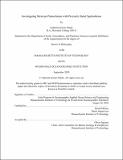Investigating Mexican paleoclimate with precisely dated speleothems
Author(s)
Serrato Marks, Gabriela.
Download1227037158-MIT.pdf (18.13Mb)
Other Contributors
Joint Program in Oceanography/Applied Ocean Science and Engineering.
Massachusetts Institute of Technology. Department of Earth, Atmospheric, and Planetary Sciences.
Woods Hole Oceanographic Institution.
Advisor
David McGee.
Terms of use
Metadata
Show full item recordAbstract
Speleothems, or sedimentary rocks formed in caves, act as valuable archives of past climate change due to their suitability for U-series dating and high-resolution proxy analysis. These records can provide insights into water availability and controls on hydrology prior to the instrumental record. In this thesis, I present three records from newly-analyzed Mexican stalagmites using stable isotope (oxygen and carbon) and trace element to calcium (Mg/Ca and Sr/Ca) ratios as proxies for changing hydroclimate. Chapter 2 presents a precisely dated, mid- Holocene record of high rainfall and limited precipitation variability in the Yucatan Peninsula, Mexico. Chapters 3 and 4 present novel climate records from northeastern Mexico, an understudied region of North America. Both records come from cave sites within the Mexican arid zone, which is simultaneously experiencing increased water scarcity and a rapidly growing population. In Chapter 3, I examine a speleothem from the first millennium of the Common Era, which showed that there is a precipitation dipole between northern and southern Mexico. Chapter 4 highlights, for the first time at decadal resolution, the northeast Mexican response to the 8.2 ka event and the Younger Dryas. These chapters show that the San Luis Potosí region is vulnerable to droughts under multiple climate mean states, and is subject to drying as Atlantic Meridional Overturning Circulation weakens due to anthropogenic climate change. The climate records detailed in this thesis improve our understanding of controls on Mexican hydroclimate and can serve as benchmarks for climate models.
Description
Thesis: Ph. D., Joint Program in Oceanography/Applied Ocean Science and Engineering (Massachusetts Institute of Technology, Department of Earth, Atmospheric, and Planetary Sciences; and the Woods Hole Oceanographic Institution), 2020 Cataloged from student-submitted PDF of thesis. "September 2020." Includes bibliographical references.
Date issued
2020Department
Joint Program in Oceanography/Applied Ocean Science and Engineering; Massachusetts Institute of Technology. Department of Earth, Atmospheric, and Planetary Sciences; Woods Hole Oceanographic InstitutionPublisher
Massachusetts Institute of Technology
Keywords
Joint Program in Oceanography/Applied Ocean Science and Engineering., Earth, Atmospheric, and Planetary Sciences., Woods Hole Oceanographic Institution.